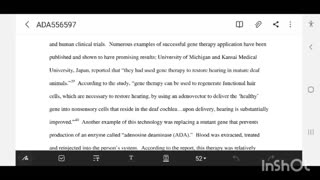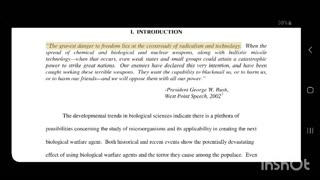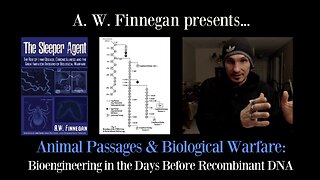Vaccines Are Being Used as Bio Weapons - Genome sequencing gave rise to a new generation of genetically engineered bioweapons carrying the potential to change the nature of modern warfare and defense
Biological weapons are designed to spread disease among people, plants, and animals through the introduction of toxins and microorganisms such as viruses and bacteria. The method through which a biological weapon is deployed depends on the agent itself, its preparation, its durability, and the route of infection. Attackers may disperse these agents through aerosols or food and water supplies.
Although bioweapons have been used in war for many centuries, a recent surge in genetic understanding, as well as a rapid growth in computational power, has allowed genetic engineering to play a larger role in the development of new bioweapons. In the bioweapon industry, genetic engineering can be used to manipulate genes to create new pathogenic characteristics aimed at enhancing the efficacy of the weapon through increased survivability, infectivity, virulence, and drug resistance. While the positive societal implications of improved biotechnology are apparent, the “black biology” of bioweapon development may be “one of the gravest threats we will face”.
Limits of Past Bioweapons
Prior to recent advances in genetic engineering, bioweapons were exclusively natural pathogens. Agents must fulfill numerous prerequisites to be considered effective military bioweapons, and most naturally occurring pathogens are ill suited for this purpose. First, bioweapons must be produced in large quantities. A pathogen can be obtained from the natural environment if enough can be collected to allow purification and testing of its properties. Otherwise, pathogens could be produced in a microbiology laboratory or bank, a process which is limited by pathogen accessibility and the safety with which the pathogens can be handled in facilities. To replicate viruses and some bacteria, living cells are required. The growth of large quantities of an agent can be limited by equipment, space, and the health risks associated with the handling of hazardous germs. In addition to large-scale production, effective bioweapons must act quickly, be environmentally robust, and their effects must be treatable for those who are implementing the bioweapon.
Recent Advances
As researchers continue to transition from the era of DNA sequencing into the era of DNA synthesis, it may soon become feasible to synthesize any virus whose DNA sequence is known. This was first demonstrated in 2001 when Dr. Eckard Wimmer re-created the poliovirus and again in 2005 when Dr. Jeffrey Taubenberger and Terrence Tumpey re-created the 1918 influenza virus. The progress of DNA synthesis technology will also allow for the creation of novel pathogens. According to biological warfare expert Dr. Steven Block, genetically engineered pathogens “could be made safer to handle, easier to distribute, capable of ethnic specificity, or be made to cause higher mortality rates”.
The growing accessibility of DNA synthesis capabilities, computational power, and information means that a growing number of people will have the capacity to produce bioweapons. Scientists have been able to transform the four letters of DNA—A (adenine), C (cytosine), G (guanine), and T (thymine)—into the ones and zeroes of binary code. This transformation makes genetic engineering a matter of electronic manipulation, which decreases the cost of the technique. According to former Secretary of State Hillary Clinton, “the emerging gene synthesis industry is making genetic material more widely available […] A crude but effective terrorist weapon can be made using a small sample of any number of widely available pathogens, inexpensive equipment, and college-level chemistry and biology.”
Text from THIS document: https://sites.dartmouth.edu/dujs/2013/03/10/genetically-engineered-bioweapons-a-new-breed-of-weapons-for-modern-warfare/
-
 33:22
33:22
nonvaxer420
1 year agoBiotechnology: Genetically Engineered Pathogens (The Counterproliferation Papers, Future Warfare Series No. 53) USAF COUNTERPROLIFERATION CENTER MAXWELL AFB AL (US BIOWARFARE MANIFESTO?!)
3.08K9 -
 4:52
4:52
Truthseekers17
1 year agoTHIS IS IN THE VACCINES — THEY ARE NOT VACCINES, BUT BIOWEAPONS
49 -
 25:42
25:42
Alice Springs To Mind
4 months agoBioweapons History, Wuhan and World Health Organization: RFK Jr Connects the Dots
80 -
 54:12
54:12
nonvaxer420
1 month ago(2010) U.S.A.F. BIOTECHNOLOGY: GENETICALLY ENGINEERED PATHOGENS (BIOWEAPONS) (Pg15) Future Application: 'Gene therapy is expected to gain in popularity.
2.57K4 -
 58:32
58:32
The Memory Hole
6 days agoThe Secret History of the CIA and the U.S. Army's Biological Warfare Efforts (1988)
678 -
 14:03
14:03
Right2Freedom
1 year agoGenomics expert discovers concerning contents in COVID vaccine vials
15.1K1 -
 26:48
26:48
AWFinnegan
5 months agoBioengineering Before the Days of Recombinant DNA : Animal Passages in Biological Warfare History
13 -
 1:28
1:28
Truthseekers17
1 year agoBioweapons, also called pharmaceuticals and vaccines, are the new depopulation programs
371 -
 16:49
16:49
Right2Freedom
1 year agoPLANDEMIC Elites BROKE Biological Weapons Anti-Terrorism Act
3634 -
 32:12
32:12
BizNewsTV
1 year ago“More pandemics are coming” – bioweapons expert Dr Boyle on WHO Treaty, Biden’s Executive Order
18.1K